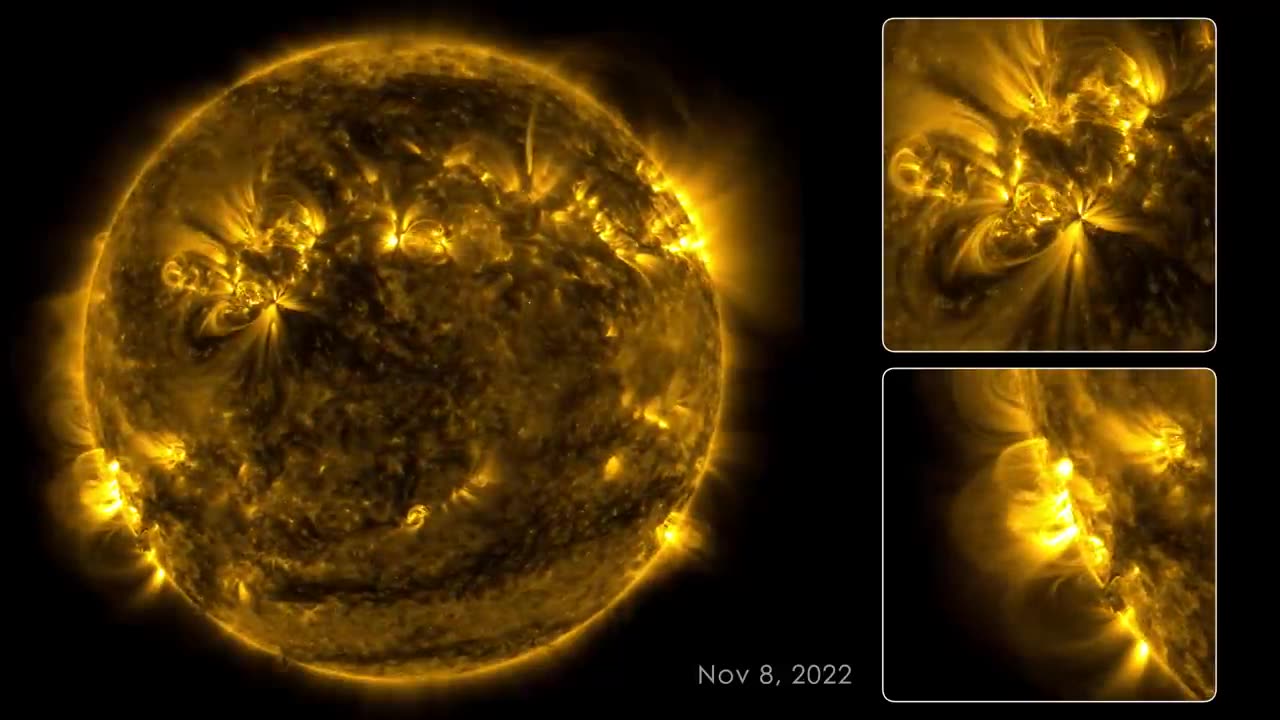Premium Only Content

133 Days On the Sun
video chronicles solar activity from Aug. 12 to Dec. 22, 2022, as captured by NASA’s Solar Dynamics Observatory (SDO). From its orbit in space around Earth, SDO has steadily imaged the Sun in 4K x 4K resolution for nearly 13 years. This information has enabled countless new discoveries about the workings of our closest star and how it influences the solar system. With a triad of instruments, SDO captures an image of the Sun every 0.75 seconds. The Atmospheric Imaging Assembly (AIA) instrument alone captures images every 12 seconds at 10 different wavelengths of light. This 133-day time lapse showcases photos taken at a wavelength of 17.1 nanometers, which is an extreme-ultraviolet wavelength that shows the Sun’s outermost atmospheric layer: the corona. Compiling images taken 108 seconds apart, the movie condenses 133 days, or about four months, of solar observations into 59 minutes. The video shows bright active regions passing across the face of the Sun as it rotates. The Sun rotates approximately once every 27 days. The loops extending above the bright regions are magnetic fields that have trapped hot, glowing plasma. These bright regions are also the source of solar flares, which appear as bright flashes as magnetic fields snap together in a process called magnetic reconnection. While SDO has kept an unblinking eye pointed toward the Sun, there have been a few moments it missed. Some of the dark frames in the video are caused by Earth or the Moon eclipsing SDO as they pass between the spacecraft and the Sun. Other blackouts are caused by instrumentation being down or data errors. SDO transmits 1.4 terabytes of data to the ground every day. The images where the Sun is off-center were observed when SDO was calibrating its instruments. SDO and other NASA missions will continue to watch our Sun in the years to come, providing further insights about our place in space and information to keep our astronauts and assets safe. The music is a continuous mix from Lars Leonhard’s “Geometric Shapes” album, courtesy of the artist. Credit: NASA's Goddard Space Flight Center Scott Wiessinger (PAO): Lead Producer Tom Bridgman (SVS): Lead Visualizer Scott Wiessinger (PAO): Editor This video can be freely shared and downloaded at https://svs.gsfc.nasa.gov/14263. While the video in its entirety can be shared without permission, the music and some individual imagery may have been obtained through permission and may not be excised or remixed in other products. Specific details on such imagery may be found here: https://svs.gsfc.nasa.gov/14263. For more information on NASA’s media guidelines, visit https://nasa.gov/multimedia/guidelines. Video Description: On the left side of the frame is the full circle of the Sun. It appears in a golden yellow color, but splotchy and with thin yellow wisps extending from the surface. Some areas are very bright and others almost black. The whole Sun rotates steadily, with one full rotation taking 12 minutes in this time lapse. There are usually only a few bright regions visible at a time and they shift and flash like small fires. From these regions there are wispy loops reaching up above the surface that rapidly change shape and size. On the right side of the frame are two white-outlined squares with enlargements of interesting regions of the Sun. If you liked this video, subscribe to the NASA Goddard YouTube channel: https://www.youtube.com/NASAGoddard Follow NASA’s Goddard Space Flight Center · Instagram http://www.instagram.com/nasagoddard · Twitter http://twitter.com/NASAGoddard · Twitter http://twitter.com/NASAGoddardPix · Facebook: http://www.facebook.com/NASAGoddard · Flickr http://www.flickr.com/photos/gsfcNew Horizons is the first mission to the Kuiper Belt, a gigantic zone of icy bodies and mysterious small objects orbiting beyond Neptune. This region also is known as the “third” zone of our solar system, beyond the inner rocky planets and outer gas giants. Johns Hopkins University Applied Physics Laboratory (APL) in Maryland, designed, built and operates the New Horizons spacecraft, and manages the mission for NASA’s Science Mission Directorate in Washington. The Year of Pluto - NASA New Horizons is a one hour documentary which takes on the hard science and gives us answers to how the mission came about and why it matters. Interviews with Dr. James Green, John Spencer, Fran Bagenal, Mark Showalter and others share how New Horizons will answer many questions. New Horizons is part of the New Frontiers Program, managed by NASA’s Marshall Space Flight Center in Huntsville, Alabama
-
 2:04:08
2:04:08
Inverted World Live
7 hours agoRex Jones Calls In From The Gray Area | Ep. 122
36.8K4 -
 5:56:17
5:56:17
Rallied
9 hours ago $4.45 earnedBF6 with THE BOYS
37.8K4 -
 1:05:18
1:05:18
Flyover Conservatives
1 day agoThe SEAL-Turned-CEO Paying Off Millions in Veteran Medical Debt: JOIN THE MISSION! - Bear Handlon, Born Primitive | FOC Show
51.1K4 -
 5:02:21
5:02:21
Drew Hernandez
11 hours agoTRUMP'S GAZA PEACE PLAN PHASE 1 & TRUMP THREATENS PUTIN WITH TOMAHAWKS
32.4K22 -
 1:18:38
1:18:38
Glenn Greenwald
9 hours agoProf. John Mearsheimer on Trump's Knesset Speech, the Israel/Hamas Ceasefire, Russia and Ukraine, and More | SYSTEM UPDATE #530
121K81 -
 2:21:37
2:21:37
Tucker Carlson
8 hours agoAlex Jones Warns of the Globalist Death Cult Fueling the Next Civil War and Rise of the Antichrist
96.4K413 -
 12:35
12:35
Clownfish TV
15 hours agoJimmy Kimmel Return NOT Helping Disney AT ALL! DIS Stock Keeps Falling! | Clownfish TV
47.7K8 -
 LIVE
LIVE
Eternal_Spartan
9 hours ago🟢 Eternal Spartan Plays Final Fantasy 7 Rebirth Ep. 10 | USMC Vet
724 watching -
 2:10:42
2:10:42
RiftTV
10 hours agoTrump SECURES Hostages, ACCIDENTALLY Admits Foreign Gov CONTROLS Him? | The Rift | Gerald Morgan Jr.
59K60 -
 6:13:34
6:13:34
Phyxicx
6 hours agoStarting Dead Space 2 - 10/13/2025
22.3K